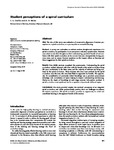Student perceptions of a spiral curriculum

Date
2016-07-11Author
Subject
Metadata
Show full item recordAbstract
<jats:title>Abstract</jats:title><jats:sec><jats:title>Aim</jats:title><jats:p>The aim of this study was evaluation of constructive alignment of student perceptions to a spiral curriculum, as a pre‐requisite to successful learning.</jats:p></jats:sec><jats:sec><jats:title>Method</jats:title><jats:p>A survey was undertaken to evaluate student thoughts and experiences of a spiral curriculum, by participation in an anonymous voluntary questionnaire. Students were asked to rate their thoughts on their understanding, perceived benefit of and confusion with their spiral curriculum at the current time and retrospectively during previous years, and to answer free‐text questions on the impact, effects on learning and future suggestions for their spiral curriculum.</jats:p></jats:sec><jats:sec><jats:title>Results</jats:title><jats:p>Sixty (86%) students completed the questionnaire. Understanding the spiral curriculum worked enhanced with time, with the benefit of the spiral curriculum being felt more conclusively in the latter years, and the majority of students not being confused by the spiral curriculum. Those students who were most confused by the spiral curriculum were the ones who were least likely to appreciate its benefits. The opportunity for consolidation of previously visited knowledge was a perceived predominant advantage, with re‐visitation of topics helping to deepen understanding and learning. Clarity on the depth of knowledge at each stage prevents information overload. A spiral curriculum must spiral and not be a repetition of previously delivered topics.</jats:p></jats:sec><jats:sec><jats:title>Conclusions</jats:title><jats:p>This study provided insights into students' perceptions of an integrated spiral curriculum, and whilst predominantly positive, there are challenges to enhance the student experience. The spiral curriculum provides an opportunity to revisit and consolidate learning to the apparent benefit of the student.</jats:p></jats:sec>
Collections
Publisher
Place of Publication
Journal
Volume
Issue
Pagination
Recommended, similar items
The following license files are associated with this item:

